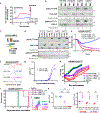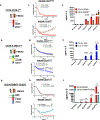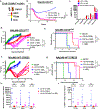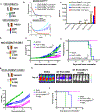Tuning the Antigen Density Requirement for CAR T-cell Activity
- PMID: 32193224
- PMCID: PMC7939454
- DOI: 10.1158/2159-8290.CD-19-0945
Tuning the Antigen Density Requirement for CAR T-cell Activity
Abstract
Insufficient reactivity against cells with low antigen density has emerged as an important cause of chimeric antigen receptor (CAR) T-cell resistance. Little is known about factors that modulate the threshold for antigen recognition. We demonstrate that CD19 CAR activity is dependent upon antigen density and that the CAR construct in axicabtagene ciloleucel (CD19-CD28ζ) outperforms that in tisagenlecleucel (CD19-4-1BBζ) against antigen-low tumors. Enhancing signal strength by including additional immunoreceptor tyrosine-based activation motifs (ITAM) in the CAR enables recognition of low-antigen-density cells, whereas ITAM deletions blunt signal and increase the antigen density threshold. Furthermore, replacement of the CD8 hinge-transmembrane (H/T) region of a 4-1BBζ CAR with a CD28-H/T lowers the threshold for CAR reactivity despite identical signaling molecules. CARs incorporating a CD28-H/T demonstrate a more stable and efficient immunologic synapse. Precise design of CARs can tune the threshold for antigen recognition and endow 4-1BBζ-CARs with enhanced capacity to recognize antigen-low targets while retaining a superior capacity for persistence. SIGNIFICANCE: Optimal CAR T-cell activity is dependent on antigen density, which is variable in many cancers, including lymphoma and solid tumors. CD28ζ-CARs outperform 4-1BBζ-CARs when antigen density is low. However, 4-1BBζ-CARs can be reengineered to enhance activity against low-antigen-density tumors while maintaining their unique capacity for persistence.This article is highlighted in the In This Issue feature, p. 627.
©2020 American Association for Cancer Research.
Conflict of interest statement
Figures







References
-
- Lee DW, Kochenderfer JN, Stetler-Stevenson M, Cui YK, Delbrook C, Feldman SA, et al. T cells expressing CD19 chimeric antigen receptors for acute lymphoblastic leukaemia in children and young adults: a phase 1 dose-escalation trial. Lancet 2015;385(9967):517–28 doi 10.1016/S0140-6736(14)61403-3. - DOI - PMC - PubMed
Publication types
MeSH terms
Substances
Grants and funding
LinkOut - more resources
Full Text Sources
Other Literature Sources
Research Materials

